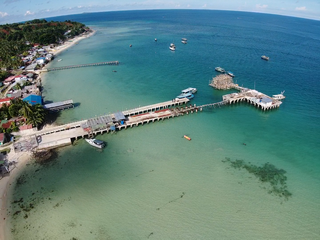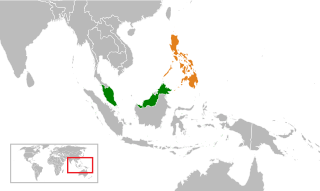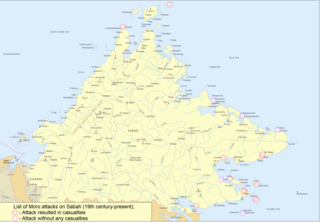
Abu Sayyaf, officially known by the Islamic State as the Islamic State – East Asia Province, is a Jihadist militant and pirate group that followed the Wahhabi doctrine of Sunni Islam. It was based in and around Jolo and Basilan islands in the southwestern part of the Philippines, where for more than five decades, Moro groups had been engaged in an insurgency seeking to make Moro Province independent. The group was considered violent and was responsible for the Philippines' worst terrorist attack, the bombing of MV Superferry 14 in 2004, which killed 116 people. The name of the group was derived from Arabic abu, and sayyaf. As of April 2023, the group was estimated to have about 20 members, down from 1,250 in 2000. They used mostly improvised explosive devices, mortars and automatic rifles.

Tawi-Tawi, officially the Province of Tawi-Tawi, is an island province in the Philippines located in the Bangsamoro Autonomous Region in Muslim Mindanao (BARMM). The capital of Tawi-Tawi is Bongao.

Sipadan is the only oceanic island in Malaysia, rising 600 metres (2,000 ft) from the seabed. It is located in the Celebes Sea off the east coast of Sabah, Malaysia. It was formed by living corals growing on top of an extinct volcanic cone that took thousands of years to develop. Sipadan is located at the heart of the Indo-Pacific basin, the centre of one of the richest marine habitats in the world. More than 400 species of fish and hundreds of coral species have been classified in this ecosystem. Sipadan Island was at the top of Rodale's Scuba Diving Magazine Gold List for 'The Top Dive Destination in the World'. In fact it shared its top spot with 2 other destinations known for the diversity of their marine life — the Galápagos Islands of Ecuador and Truk in Micronesia. Furthermore, one of the dive operators; Scuba Junkie was voted by the public the "Best Dive Resort in the World 2020" at DiveMagazine's annual Dive Travel Awards.

Sandakan formerly known at various times as Elopura, is the capital of the Sandakan District in Sabah, Malaysia. It is the second largest city in Sabah after Kota Kinabalu. It is located on the Sandakan Peninsula and east coast of the state in the administrative centre of Sandakan Division and was the former capital of British North Borneo. In 2010, the city had an estimated population of 157,330 while the overall municipal area had a total population of 396,290. The population of the municipal area had increased to 439,050 by the 2020 Census.

Turtle Islands, officially the Municipality of Turtle Islands, is a 5th class municipality in the province of Tawi-Tawi, Philippines. According to the 2020 census, it has a population of 5,683 people, making it the least populated town in the province.
Turtle Islands Park is located within the Turtle Islands, which lie in the Sulu Sea some 3 kilometres north of Sandakan in Sabah, Malaysia. It consists of 3 islands - Selingaan, Little Bakkungan and Gulisaan, including the surrounding coral reefs and ocean. The Park is noted for its green turtles and hawksbill turtles which lay their eggs on the beaches of the islands. The Park covers an area of 17.4 km². The name Turtle Islands, however, refers to 10 islands, 3 of which are part of Turtle Islands Park of Malaysia, and 7 which belong to the Turtle Islands Wildlife Sanctuary of Tawi-Tawi province, Philippines.

The North Borneo dispute, also known as the Sabah dispute, is the territorial dispute between Malaysia and the Philippines over much of the eastern part of the state of Sabah. Sabah was previously known as North Borneo prior to the formation of the Malaysian federation.

Malaysia–Philippines relations refers to the bilateral relations between Malaysia and the Philippines. The Philippines has an embassy in Kuala Lumpur, and Malaysia has an embassy in Manila and a consulate general in Davao City. The people of the two neighbouring countries have a long history of cultural and political relations.

The Berhala Island is a small forested island situated in Sandakan Bay in Sandakan, Sabah, Malaysia.

The history of Sabah can be traced back to about 23–30,000 years ago when evidence suggests the earliest human settlement in the region existed. The history is interwoven with the history of Brunei and the history of Malaysia, which Sabah was previously part of and is currently part of respectively. The earliest recorded history of Sabah being part of any organised civilisation began in the early 15th century during the thriving era of the Sultanate of Brunei. Prior to this, early inhabitants of the land lived in predominantly tribal societies, although such tribal societies had continued to exist until the 1900s. The eastern part of Sabah was ceded to the Sultan of Sulu by the Sultan of Brunei in 1658 for the former helping a victory over Brunei enemies, but many sources stated it had not been ceded at all. By the late 19th century, both territories previously owned by Sultan of Brunei and Sultan of Sulu was granted to British syndicate and later emerged as British North Borneo under the management of the North Borneo Chartered Company. Sabah became a protectorate of the United Kingdom in 1888 and subsequently became a Crown colony from 1946 until 1963, during which time it was known as Crown Colony of North Borneo. On 16 September 1963, Sabah merged with Malaya, Sarawak and Singapore to form Malaysia.
Albader Parad was a senior leader of Abu Sayyaf, a group of Islamic militants in the Philippines with links to al-Qaeda. He led the kidnapping of three International Committee of the Red Cross workers in 2009 and was implicated in the 2000 Sipadan kidnappings, where 20 foreign tourists and a Filipino were abducted from the Sipadan Island Diving Resort in Sandakan, Sabah in Malaysia.

The Bangsamoro are a majority-Muslim ethnic group occupying a range of territories across the southern portions of the Republic of the Philippines. On three occasions, a short-lived and unrecognized Bangsamoro state independent of the Philippines has been formally declared by the Moro National Liberation Front (MNLF). The first declaration was issued in 1974, amid the Moro conflict. Bangsamoro Land would be declared in 2012. In 2013, the United Federated States of Bangsamoro Republik was declared.

The Crown Colony of North Borneo was a Crown colony on the island of Borneo established in 1946 shortly after the dissolution of the British Military Administration. The Crown Colony of Labuan joined the new Crown Colony during its formation. It was succeeded as the state of Sabah through the formation of the Federation of Malaysia on 16 September 1963.

The cross border attacks in Sabah are a series of cross border terrorist attacks perpetrated by Moro pirates from Mindanao, Philippines, in the state of Sabah, Malaysia, that began even before the British colonial period. Many civilians have died or suffered during these incidents, causing an increase in anti-Filipino sentiment among the native peoples of Sabah, especially after major attacks in 1985, 2000 and 2013. The attacks were more intense during the presidential terms of Diosdado Macapagal and Ferdinand Marcos, who supported irredentist claims to include eastern Sabah as part of the Philippines territory. In addition, recent infiltration and attacks by militants as well as uncontrolled human migration from Mindanao to Sabah has led to more unease sentiments among the local residents of Sabah, with around 78% of prison inmates that were caught in the state due to involvement in criminal activities and lawlessness issues mainly originating from the southern Philippines.

The Ligitan and Sipadan dispute [2002] ICJ 3 was a territorial dispute between Indonesia and Malaysia over two islands in the Celebes Sea, namely Ligitan and Sipadan. The dispute began in 1969 and was largely resolved by the International Court of Justice (ICJ) in 2002, which opined that both of the islands belonged to Malaysia.
The following is a list of attacks which have been carried out by Abu Sayyaf, a militant group based in and around Jolo and Basilan islands in the southwestern part of the Philippines, where for more than four decades, Moro groups have been engaged in an insurgency for an independent province in the country.
The Mangsee Islands are a group of two small islands in the far south west portion of the Philippines. The group comprises North Mangsee Island and South Mangsee Island. Together they form a barangay within the Balabac, a municipality of the province of Palawan. Based on the 2010 Census, the population of the Mangsee Islands was 8,433. By the time of the 2015 Census, the population has grown into 9,016.
Great Bakkungaan Island is a small tropical island surrounded by the Sulu Sea in the province of Tawi-Tawi, Philippines. The island is one of the seven Philippine Turtle Islands.

Filipino refugees are persons originating from the country of the Philippines. Following the Moro conflict and subsequent major military operation in the islands of Mindanao during the administration of President Ferdinand Marcos in 1970s, thousands of Filipinos mainly from the Moro ancestry have sought refuge in neighbouring countries of Malaysia, Indonesia and Brunei, with majority of them mostly heading to the state of Sabah in Malaysia.

Turtle Islands Wildlife Sanctuary is a protected area encompassing the municipality of Turtle Islands in Tawi-Tawi, Philippines. It spans six islands: Great Bakkungan, Baguan, Boan, Langaan, Lihiman, and Taganak.

















